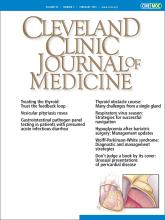
The mechanisms for cellular effects of thyroid hormones on target tissues in the periphery and on the pituitary gland for negative feedback control of thyroid-stimulating hormone (TSH) release are complex.1 Interaction with genomic receptors directly affects transcriptional elements, other effects are mediated via interactions with the plasma membrane, and some hypermetabolic effects result from direct interaction of thyroid hormones with mitochondria. The systemic clinical effects are myriad. In addition to effects on the basal metabolic rate, thyroid hormones increase expression of beta-adrenergic receptors on the surface of cardiac myocytes2 and decrease the level of circulating low-density lipoprotein (LDL) cholesterol by both stimulating the conversion of hepatocyte cholesterol to bile acids and reducing the level of proprotein convertase subtilisin/kexin type 9,3 an enzyme that degrades hepatic LDL receptors, resulting in increased clearance of circulating LDL cholesterol by the liver. Many factors external to the thyroid gland can modulate these diverse effects, making it difficult to assess the thyroid status of patients solely on clinical grounds.
I contrast the complexity of thyroid hormone functions with the relative simplicity and reliability of the pituitary-thyroid axis that dictates hormone output by the functioning thyroid gland. It is sufficiently straightforward that a thermostat and furnace analogy works reasonably well for almost all patients, and can help guide our clinical reasoning. Measurement of the TSH alone (the thermostat setting) is sufficient for initial screening and follow-up for most patients with suspected or known thyroid disease, yet multiple studies have demonstrated that we order more free thyroxine (T4) and triiodothyronine (T3) levels than are necessary.4 While there are always exceptional situations, we should apparently trust the TSH feedback loop more than we do.
In this issue of the Journal, Bodnar and Saberi5 discuss a patient with apparent hyperthyroidism, which was suspected based on an abnormally low TSH level. In their Symptoms to Diagnosis article, the authors work through with the reader the patient’s clinical course after the initial diagnosis.
But I want to discuss briefly an alternative scenario in which a patient is found to have a slightly elevated TSH. Once the abnormal TSH level is detected (but not before), it is appropriate to check a free T4 level to distinguish the patient with true primary hypothyroidism from the rarer scenario of inappropriate secretion of TSH from the pituitary (or another site). Although routine testing of TSH in asymptomatic patients has been strongly discouraged,6 the symptoms consistent with mild hypothyroidism are diverse and nonspecific enough that testing is often warranted.
Not infrequently, mild elevations in TSH are accompanied by a free T4 level in the normal range. The TSH, when rechecked (as it should be), may be back in the normal range, since low-level TSH elevations may physiologically fluctuate by as much as 40%,7 while free T4 levels may vary by 15%. But the persistent demonstration of what is usually a minimal elevation of TSH with a normal free T4 defines subclinical hypothyroidism.
Many patients with subclinical hypothyroidism can be observed off treatment, with scheduled rechecking of TSH and free T4, because some patients will develop clinical hypothyroidism. The highest estimate of progression of patients to overt hypothyroidism that I found in the literature was 58% over 10 years, but, importantly, this was in patients who all had antiperoxidase thyroid antibodies,8 the major measurable factor predicting ultimate thyroid failure. Other factors that increase the risk of progression include being female, having a higher TSH level (> 10 mIU/L), having heterogeneous thyroid tissue on ultrasonography examination, or having a very low normal T4. But without the presence of antiperoxidase antibodies, the risk of progression is low. In the absence of changing clinical symptoms or otherwise unexplained laboratory findings such as rising LDL cholesterol, repeat measurement of TSH and free T4 every 12 months, or every 6 months in the presence of antiperoxidase antibodies, seems reasonable. There is no need to recheck antibody titers or to check reverse T3 levels.9 Evaluating and following patients with subclinical hyperthyroidism is different, and checking the free T3 level is also important, especially in patients who may have Graves disease.10 Letting trust in the reliability of the physiology dictate our thyroid testing makes good clinical sense, and is cost-effective.
- Copyright © 2025 The Cleveland Clinic Foundation. All Rights Reserved.






